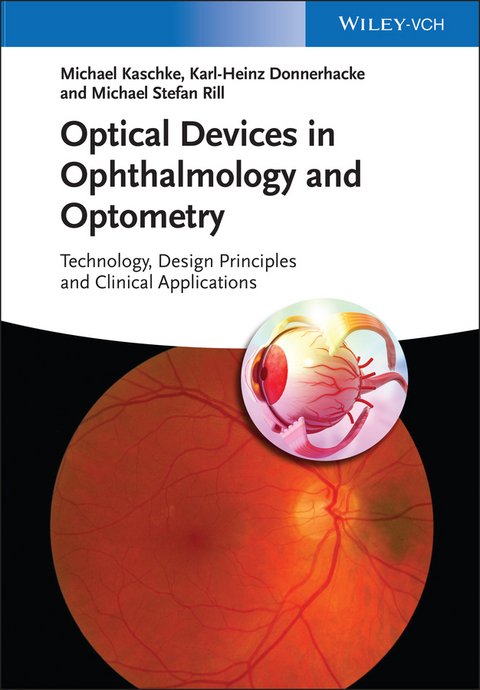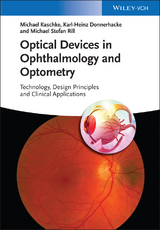Optical Devices in Ophthalmology and Optometry
Wiley-VCH (Verlag)
978-3-527-41068-2 (ISBN)
Michael Kaschke received his Ph.D. and Dr. sc. nat. degrees both from the University of Jena in 1986 and 1988, respectively, for his research in the field of ultra-short light pulses and spectroscopy. Before joining Carl Zeiss, he was a research scientist at the Max-Born-Institute Berlin, Max-Planck-Institute Göttingen, and invited visiting scholar at IBM Research Center Yorktown Heights, N.Y., working on high-power fs-laser pulses and their matter interaction. He is also a professor for medical technology at the Karlsruhe Institute of Technology, Germany. Michael Kaschke is President and CEO of the Carl Zeiss AG, a technology leader in optics, optoelectronic, and medical technology headquartered in Oberkochen, Germany. He joined Carl Zeiss in 1992 and has held since then several research and management positions in the company predominantly in the medical business. Karl-Heinz Donnerhacke received his Ph.D. degree from the University of Jena, Germany, in 1976 for his research in the field of high power gas lasers. He spent over 25 years of his career working at Carl Zeiss in laser development and laser application in medicine. During this time, he also joined the University of Jena and the Physical-Technical Institute of the Academy of Sciences as a research scientist. Until his retirement he was Director of R&D in the Ophthalmic Instruments Division of Carl Zeiss for more than 15 years and later Director of R&D for Ophthalmic Diagnostic Instruments at Carl Zeiss Meditec AG. Since 2003, Dr. Donnerhacke has been adjunct professor for ophthalmic technology at the Ernst Abbe University of Applied Sciences Jena, Germany and the Technical University Ilmenau, Germany. Currently, he is also a technical consultant in the field of ophthalmic devices. Michael Stefan Rill received his Ph.D. degree from the Institute of Applied Physics at the Karlsruhe Institute of Technology, Germany, in 2010 for his research in the field of 3D photonic metamaterials. He subsequently worked as a sales manager at Nanoscribe GmbH in Eggenstein-Leopoldshafen, Germany, and as a scientific assistant to the CEO at Carl Zeiss in Oberkochen, Germany. As of 2013, Dr. Rill holds a position as product manager for cataract surgery systems at Carl Zeiss in Jena, Germany.
PART I
1. Structure and Function
2. Optics of the Human Eye
3. Visual Disorders and Major Eye Diseases
PART II
4. Introduction to Ophthalmic Diagnosis and Imaging
5. Determination of the Refractive Status of the Eye
6. Optical Visualization, Imaging, and Structural Analysis
7. Optical Coherence Methods for Three-Dimensional Visualization and Structural Analysis
8. Functional Diagnostics
PART III
9. Laser-Tissue Interaction
10. Laser Systems for Treatment of Eye Diseases and Refractive Errors
PART IV
A. Basics of Optics
B. Basics of Laser Systems
C. Used Variables and Abbreviations
"The book is clearly written with many excellent illustrations." ( Optics and Photonics News , 31 October 2014)
"Optical Devices in Ophthalmology and Optometry sets a very high standard for biomedical optics textbooks. I am impressed with the integration of the mathematical physics, the explanations of the fundamental physics with the emphasis on physical insights, the instrument design principles and their relation to the function of resulting medical device, and the clear explanations of the coupling between the optical properties of the eye and the coupling with the optical devices." ( Journal of Biomedical Optics , 1 July 2014)
| Erscheint lt. Verlag | 22.1.2014 |
|---|---|
| Verlagsort | Weinheim |
| Sprache | englisch |
| Maße | 170 x 244 mm |
| Gewicht | 1510 g |
| Themenwelt | Medizin / Pharmazie ► Medizinische Fachgebiete ► Augenheilkunde |
| Naturwissenschaften ► Physik / Astronomie ► Optik | |
| Technik ► Maschinenbau | |
| Schlagworte | Apparatetechnik u. Biosensoren • Bildgebende Systeme u. Verfahren • Bioinstrumentation & Biosensors • Bioinstrumentation & Biosensors • biomedical engineering • Biomedizintechnik • Biophysics • Biophysik • Biowissenschaften • Electrical & Electronics Engineering • Electrical & Electronics Engineering • Elektrotechnik u. Elektronik • Endoscopy • Endoskopie • Imaging Systems & Technology • Imaging Systems & Technology • Laser • Life Sciences • Materials Science • Materialwissenschaften • Medical & Health Physics • Medical & Health Physics • Medical Science • Medizin • Microscopy • Mikroskopie • Ophthalmologie • Ophthalmologie u. Optometrie • Ophthalmologisch-optisches Instrument • Ophthalmology & Optometry • Ophthalmology & Optometry • Optical and Non-Linear Optical Materials • Optics & Photonics • Optics & Photonics • Optik • Optik u. Photonik • Optische u. Nichtlineare Optische Materialien • Optometrie • Photonics & Lasers • Photonics & Lasers • Photonik u. Laser • Physics • Physik • Physik in Medizin u. Gesundheitswesen • Robotics • Robotik |
| ISBN-10 | 3-527-41068-6 / 3527410686 |
| ISBN-13 | 978-3-527-41068-2 / 9783527410682 |
| Zustand | Neuware |
| Haben Sie eine Frage zum Produkt? |
aus dem Bereich





